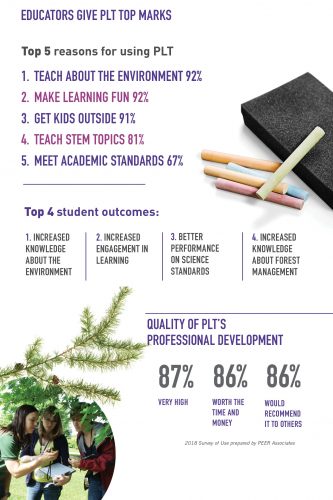PLT IS EFFECTIVE AND ADAPTABLE
Nine in ten educators say their students showed moderate to significant gains in knowledge about the environment. Nearly eight in ten say students showed moderate to significant gains in other academic subjects and reasoning skills.
Student Academic Improvement
PLT materials are proven to achieve statistically significant gains in student content knowledge and attitudinal growth about the environment. Average knowledge gains for students in grades 2-8 who were exposed to PLT for two to three weeks were no less than the equivalent of seven months of exposure. These findings are supported by rigorous quasi-experimental evaluations using both traditional pre- and post-test procedures and alternative assessment techniques, conducted by the Research Committee of the North American Association for Environmental Education (NAAEE). More than 300 professionals have participated in evaluations for the PreK-8 Activity Guide, with many hundred more testing the early childhood and secondary curriculum materials.
Student Engagement
PLT’s GreenSchools program contributes positively to important outcomes in student learning and engagement, including students’ presentation, writing, planning, problem-solving, technology, leadership, and teamwork skills. The program also helps schools and communities to reduce their ecological footprint. Students who participate in GreenSchools and environmental action projects report interest in careers in STEM (science, technology, engineering, and mathematics), namely environmental sciences and engineering.
Use by Educators
Educators who are trained in PLT actively use it. According to an annual survey of PLT educators, over 85% use it annually in their classrooms and other settings, typically in week-long blocks of time. Well over half of them also indicate that PLT plays a significant or greater role in their classroom and they use it at least once a month.
Educators agree that PLT is good for getting children outside and having fun while learning about the environment. They also agree that the curriculum materials are useful for teaching academic standards.
What Others Say
PLT materials receive “straight A’s” and ratings of excellence when reviewed by other leaders in environmental education. NAAEE and the California Department of Education conducted criteria-based reviews of PLT materials. PLT received among the highest ratings for its high quality instructional materials.
PLT’s reputation for high quality materials and professional development is fueled by word-of-mouth and demonstrated by ongoing demand. Fully 60% of new users say they came to a PLT workshop because a colleague recommended it. And 20,000-30,000 educators attend PLT workshops every year. More than 200,000 educators maintain ongoing contact with PLT through our state and national networks.
 Continuous Improvement
Continuous Improvement
PLT is committed to ongoing evaluation and continuous improvement. PLT materials are constantly reviewed and updated to remain current with education trends. New and revised curriculum materials undergo formative and summative evaluations. The quality of our professional development is monitored and improved with findings from participant surveys, state-based evaluations, and a national survey of use.
A 2018 survey of use among educators trained in PLT, conducted by PEER Associates, identified the top 4 students outcomes from using PLT are:
- Increased knowledge about the environment
- Increased engagement in learning
- Better performance on science standards
- Increased knowledge about forest management
Educators also rated the quality of PLT’s professional development:
- 87% – Very High
- 86% – Worth the Time and Money
- 86% – Would Recommend it to Others
A standing committee sets priorities for PLT’s ongoing research and evaluation activities, advising on internal research efforts and reviewing the many requests received annually from external evaluators.
Contact PLT for more information about individual research and evaluation reports.
Also see Research into the Benefits of Environmental Education.

